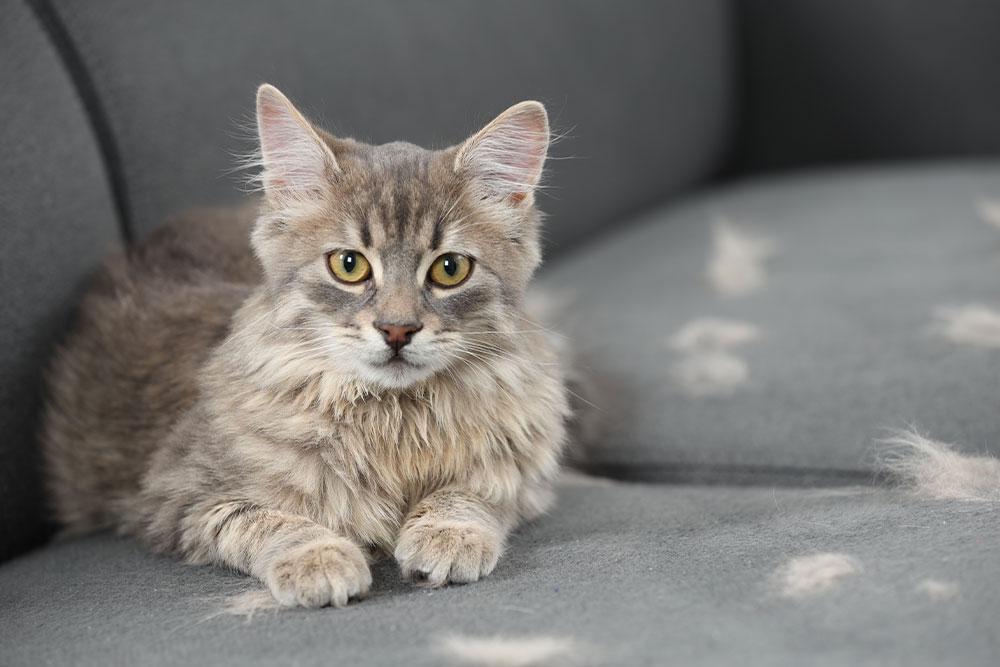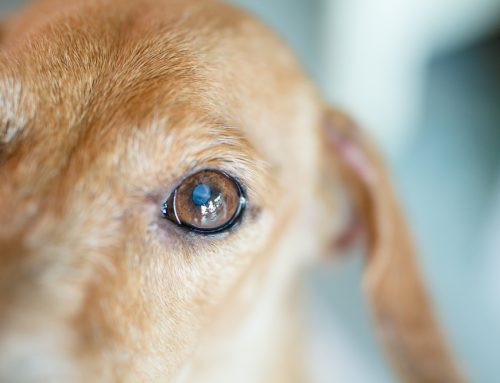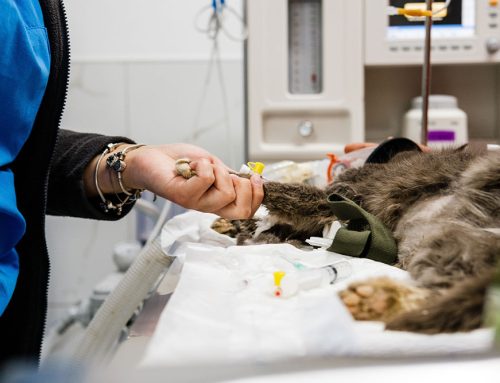Hair loss, or alopecia, in dogs and cats can signal underlying health issues that need attention. While some shedding is normal, excessive or patchy hair loss may indicate allergies, infections, hormonal imbalances, genetic conditions, or even pain-related issues. Early identification of the cause can significantly improve treatment effectiveness and enhance your pet’s quality of life.
At Milford Animal Hospital in Milford, PA, our team is dedicated to diagnosing and treating the various causes of hair loss in pets.
Signs and Symptoms of Hair Loss in Pets
It’s important to differentiate normal shedding from hair loss that may require veterinary attention. Symptoms of concern include:
- Patchy Hair Loss – Fur falls out in specific areas, leaving skin exposed.
- Complete Hair Loss – Severe cases may lead to large bald patches.
- Thinning Fur – The coat appears less lush than usual.
- Redness or Irritation – The skin appears inflamed or swollen.
- Excessive Scratching or Biting – A sign of discomfort that may indicate allergies or parasites.
- Strong Odor or Scabs – Could suggest a skin infection requiring immediate treatment.
If your pet’s hair loss is accompanied by lethargy, weight loss, or behavioral changes, schedule a veterinary appointment as soon as possible.
Common Causes of Hair Loss in Pets
1. Allergies
Allergies are a leading cause of hair loss in dogs and cats. They can be triggered by:
- Food Allergies – Some pets react to proteins or additives, leading to skin irritation and hair loss.
- Environmental Allergies – Pollen, mold, dust mites, and household chemicals can cause irritation.
- Flea Allergies – Even a single flea bite can trigger intense itching in sensitive pets.
Managing allergies is key to controlling hair loss. Learn more:
Dog Allergies: Symptoms & Treatment – AKC
Allergy Tips for Small Animals – Purdue Veterinary Hospital
2. Parasites and Skin Infections
External parasites like fleas, mites, and ticks can lead to intense scratching and bald patches. Mange, caused by mites, can result in scaly skin, redness, and secondary infections if left untreated. Fungal infections like ringworm can also cause patchy hair loss.
Learn more about preventing parasites
3. Hormonal Imbalances
- Hypothyroidism – An underactive thyroid can cause hair thinning, brittle fur, and weight gain.
- Cushing’s Disease – Excess cortisol can lead to symmetrical hair loss, a pot-bellied appearance, and increased thirst.
- Hormone Cream Exposure – If pet owners use hormone-based medications or creams, pets can absorb these substances through licking or skin contact, leading to unexpected hormonal imbalances and hair loss.
Hormonal conditions often require lifelong treatment, including medications and dietary adjustments.
4. Genetic and Color-Related Hair Loss
Some breeds are predisposed to hair loss due to genetic factors. Common conditions include:
- Color Dilution Alopecia – Seen in some blue or fawn-colored dogs, this condition causes progressive hair thinning and brittle fur.
- Breed-Specific Hair Loss – Certain breeds, such as Doberman Pinschers, Dachshunds, and Chihuahuas, are prone to inherited hair loss patterns.
While genetic alopecia is not curable, specialized grooming and skin care routines can help maintain coat health.
5. Stress and Anxiety
Excessive grooming due to stress or anxiety—a condition known as psychogenic alopecia—is common in cats. Dogs may chew or lick their paws excessively, leading to hair loss and sores.
Common Stress Triggers:
- Changes in the household (new pets, moving, or loud noises).
- Boredom or lack of stimulation.
- Separation anxiety.
Creating a consistent routine, providing mental stimulation, and using calming aids can help reduce stress-related hair loss.
6. Pain-Induced Hair Loss
Pets experiencing chronic pain—such as arthritis, nerve pain, or injuries—may excessively lick, bite, or chew at the affected area, leading to hair loss, sores, and even infections.
Signs Your Pet May Be in Pain:
- Licking or chewing a specific spot frequently.
- Reluctance to move, jump, or play.
- Whining or withdrawing from interaction.
Addressing the underlying pain through medication, therapy, or lifestyle changes can help prevent further hair loss and discomfort.
7. Nutritional Deficiencies
A poor diet lacking in essential nutrients—such as omega fatty acids, zinc, or vitamin A—can lead to dull fur, excessive shedding, and skin irritation.
Key Nutrients for a Healthy Coat:
- Omega-3 & Omega-6 fatty acids – Reduce inflammation and promote a shiny coat.
- High-quality protein – Essential for skin and fur growth.
- Vitamins A & E – Support skin repair and hydration.
Diagnosing Hair Loss in Pets
At Milford Animal Hospital, we use advanced diagnostic tools to determine the cause of hair loss, including:
- Skin Scrapings – To check for parasites, bacteria, or fungal infections.
- Blood Tests – To detect hormonal imbalances or underlying illnesses.
- Allergy Testing – Identifies environmental or food allergens.
- Biopsy or Culture – For persistent, unexplained skin conditions.
Treatment Options for Hair Loss
Veterinary Treatments
- Medications – Antihistamines, corticosteroids, antifungals, or antibiotics.
- Topical Therapies – Medicated shampoos, sprays, or creams to soothe irritated skin.
- Hormonal Therapy – For conditions like hypothyroidism or Cushing’s disease.
- Flea and Parasite Prevention – Year-round protection is essential.
For grooming tips that promote skin health, visit ASPCA
Home Care Strategies
- Regular Grooming – Helps distribute natural oils and removes dead hair.
- Flea Control – Year-round prevention reduces itching and skin irritation.
- Balanced Diet – Supports coat health and reduces excessive shedding.
- Stress Reduction – Calming supplements, pheromone diffusers, or increased playtime.
Preventing Hair Loss in Pets
- Routine Veterinary Check-Ups – Early detection of issues prevents complications.
- Consistent Flea and Parasite Control – Protects against skin irritation and disease.
- Healthy Diet – Ensuring proper nutrition for skin and coat health.
- Regular Grooming and Hygiene – Keeps skin clean and free from irritants.
For an appointment, visit our Contact Page
FAQs on Hair Loss in Pets
How can I tell the difference between normal shedding and problematic hair loss?
Normal shedding occurs evenly across the coat. Problematic hair loss causes bald patches, excessive scratching, or skin changes.
When should I take my pet to the vet for hair loss?
If hair loss is persistent, patchy, or accompanied by other symptoms (redness, odor, lethargy, or weight loss).
Can diet help prevent hair loss?
Yes! High-quality protein, omega fatty acids, and vitamins A & E are essential for healthy skin and fur.
Expert Care for Pets at Milford Animal Hospital
If you notice persistent shedding, itching, or bald patches, it’s best to seek veterinary evaluation as soon as possible.
At Milford Animal Hospital, we’re dedicated to keeping your pet’s coat healthy and ensuring their overall well-being!








Leave A Comment